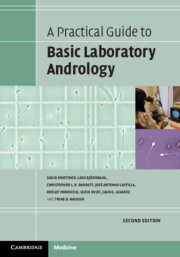Book contents
- A Practical Guide to Basic Laboratory Andrology
- A Practical Guide to Basic Laboratory Andrology
- Copyright page
- Contents
- Abbreviations
- Chapter 1 Introduction
- Chapter 2 Basic Physiology
- Chapter 3 Basic Semen Examination
- Chapter 4 Extended Semen Analysis
- Chapter 5 Sperm DNA
- Chapter 6 Computer-Aided Sperm Analysis
- Chapter 7 Sperm Function Tests
- Chapter 8 Tests of Sperm-Cervical Mucus Interaction
- Chapter 9 Sperm Preparation
- Chapter 10 Sperm Cryopreservation
- Chapter 11 Preparation of Surgically Retrieved Spermatozoa
- Chapter 12 Quality Management and Accreditation
- Chapter 13 Risk Management
- Chapter 14 Reproductive Toxicology
- Chapter 15 Andrology Laboratory Safety
- Book part
- Index
- References
Chapter 7 - Sperm Function Tests
Published online by Cambridge University Press: 16 February 2022
- A Practical Guide to Basic Laboratory Andrology
- A Practical Guide to Basic Laboratory Andrology
- Copyright page
- Contents
- Abbreviations
- Chapter 1 Introduction
- Chapter 2 Basic Physiology
- Chapter 3 Basic Semen Examination
- Chapter 4 Extended Semen Analysis
- Chapter 5 Sperm DNA
- Chapter 6 Computer-Aided Sperm Analysis
- Chapter 7 Sperm Function Tests
- Chapter 8 Tests of Sperm-Cervical Mucus Interaction
- Chapter 9 Sperm Preparation
- Chapter 10 Sperm Cryopreservation
- Chapter 11 Preparation of Surgically Retrieved Spermatozoa
- Chapter 12 Quality Management and Accreditation
- Chapter 13 Risk Management
- Chapter 14 Reproductive Toxicology
- Chapter 15 Andrology Laboratory Safety
- Book part
- Index
- References
Summary
Provides methods for a range of common sperm function tests that are structured as standard operating procedures (SOPs) for easy use at the bench. Methods are focussed on objectivity, robustness, standardized reporting, controlling the risk of errors, and minimizing measurement uncertainty. Includes sperm hyperactivation, acrosome reaction testing, and sperm-zone pellucida binding tests (hemi-zona and competititve binding formats). A protocol for using the sperm survival test in also provided. Limitations of the hyaluronan bibding assay, and of sperm fertilizing ability testing using zona pellucida-free hanster oocytes, are summarized.
Keywords
- Type
- Chapter
- Information
- A Practical Guide to Basic Laboratory Andrology , pp. 155 - 174Publisher: Cambridge University PressPrint publication year: 2022



